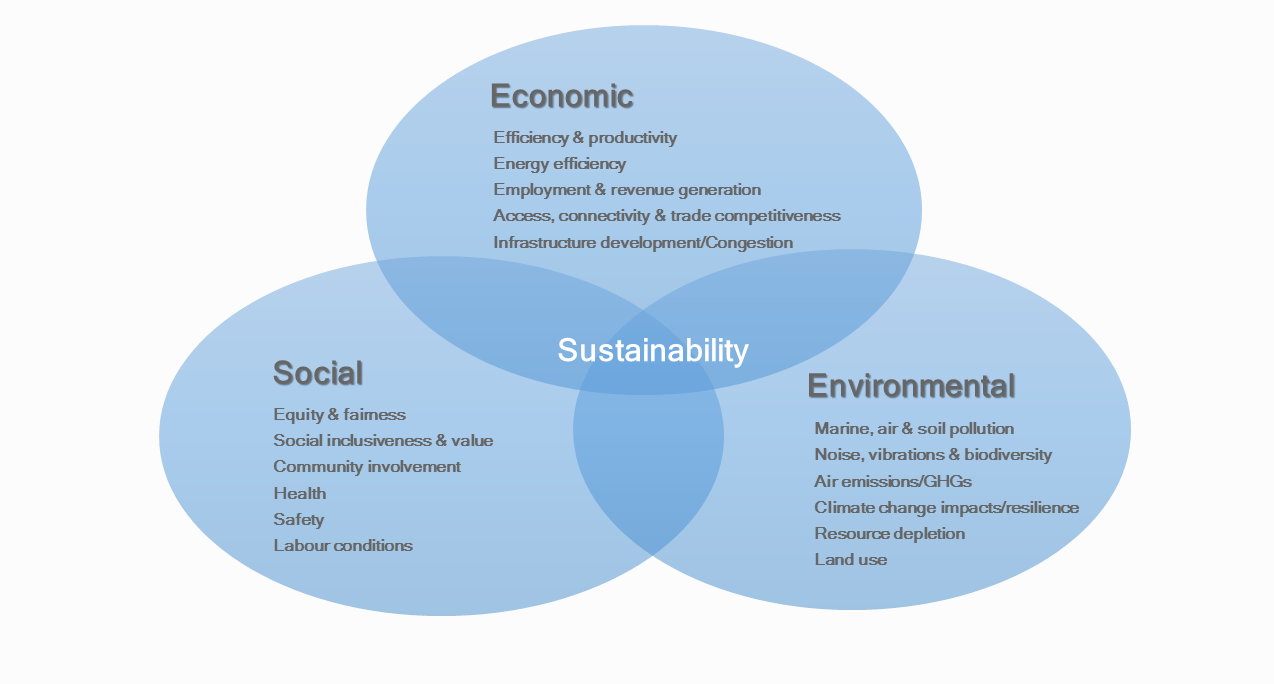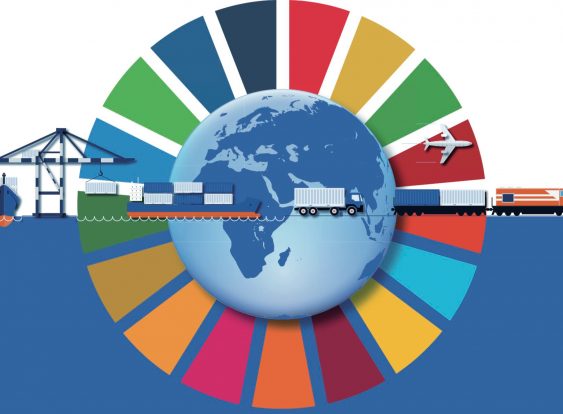UNCTAD Sustainable Freight Transport Portal
The three pillars of sustainable freight transport
Sustainable transport has long been recognized as a key development objective at various global forums, including the 1992 Earth Summit, the United Nations Conference on Sustainable Development (RIO+20), UNCTAD XIII, and, more recently, by the United Nations General Assembly resolution on the “Role of transport and transit corridors in ensuring international cooperation, stability and sustainable development.” In addition to recognizing the importance of sustainability in transport, a United Nations Secretary-General High-level Advisory Group on Sustainable Transport has been established to provide recommendations on sustainable transport that are actionable at global, national and local as well as at sector levels.
Existing definitions of sustainable transport may vary and promote one particular dimension such as the environment (green transport), society (inclusive transport) or the economic dimension (efficient and competitive transport). Generally however, sustainable freight transport aims to balance the economic, social and environmental dimensions of the sector in an integrated manner to ensure synergies, complementarities and coherence. While not intended as an exhaustive list, sustainable freight systems entail, among other features, the ability to provide transportation that is safe, socially inclusive, accessible, reliable, affordable, fuel-efficient, environmentally friendly, low-carbon, and resilient to shocks and disruptions, including those caused by climate change and natural disasters. The figure below illustrates the intersection between the economic, social and environmental dimensions of sustainable development as applicable to freight transport.
The three pillars of sustainable freight transport
 UNCTAD has long recognized the many dimensions of freight transport. Over recent years, in particular since UNCTAD XII and UNCTAD XIII, UNCTAD has carried out relevant work along its three pillars of work to help developing countries to achieve greater sustainability and resilience in their freight transport sector. Related is the UNCTAD XIII side event panel discussion "Paving the Way for Sustainable Freight Transport," held on 25th April 2012 at the UNCTAD XIII Conference in Doha, Qatar.
UNCTAD has long recognized the many dimensions of freight transport. Over recent years, in particular since UNCTAD XII and UNCTAD XIII, UNCTAD has carried out relevant work along its three pillars of work to help developing countries to achieve greater sustainability and resilience in their freight transport sector. Related is the UNCTAD XIII side event panel discussion "Paving the Way for Sustainable Freight Transport," held on 25th April 2012 at the UNCTAD XIII Conference in Doha, Qatar.
UNCTAD will continue to assist developing countries, in particular least developed countries (LDCs), landlocked developing countries (LLDCs) and small island developing states (SIDS) in making informed policy choices to address the emerging environmental and social challenges in relation to transport strategies, and to provide associated capacity-building needs and appropriate policy responses.
Selected issues challenging the sustainability of freight transport
Although challenges to sustainability in freight transport span a broad range of issues, the following will focus on the strong nexus between energy, air emissions and GHGs as well as on the persistent transport infrastructure gap and investment needs and related implications for access and connectivity. Other key sustainability issues, including labour conditions, health, noise, safety, and climate impacts, adaptation and resilience (1) also remain, however, critical to the sustainability and resilience debate in freight transport.
Energy and transport costs
Freight transport relies heavily on oil for propulsion and is not yet in a position to fully switch to other cleaner alternative energy sources. This enhances the exposure of freight rates and transport costs to oil price volatility and surges in prices in particular. Although the mid-2014 drop in oil and bunker fuel prices may be a welcome development, the effect is likely to be short-lived given the projected growth in global energy demand and the risk of rapid cuts in oil production due to reduced investment in the oil extractive and refining industries (2).
As developing countries are already facing disproportionately higher transport costs (3), the negative implications of volatile oil and fuel costs for their sustainable development can be significant, as is the need to address the long-term implications of an overdependence on oil (4).
Countries in the Pacific region, for example, are very dependent on imported fossil fuels where transport, mainly by sea, accounts for about 70 per cent of total fuel consumed (5). Consequently, maritime transport becomes commercially unaffordable and unsustainable, and governments are often required to subsidize or service certain coastal shipping routes to maintain domestic and inter-island transport connectivity (6).
Energy, environment and carbon emissions
The discussion on energy, transport and sustainability is linked to the current debate on addressing sustainable development imperatives and climate change. The negative environmental impact of oil consumption, including air pollution and GHG emissions, is a major concern. In this context, locking in fossil fuels and related technologies in freight transport systems will perpetuate unsustainable transport patterns and undermine efforts to maintain carbon emissions at manageable levels. According to the International Energy Agency (IEA), a peak in global energy-related emissions needs to be reached by 2020 to ensure manageable global warming levels. To achieve this objective, the strategy proposed by IEA includes enhancing energy efficiency in the transport sector (7).
Freight transport and related GHG emissions are at the centre stage of the current climate change debate, including under the United Nations Framework Convention on Climate Change (UNFCCC) and International Maritime Organization (IMO) frameworks. More specifically, international shipping is under greater pressure to be regulated by an international binding legal instrument. In 2011, IMO adopted a set of technical and operational measures under the mandated Energy Efficiency Design Index and the Ship Energy Efficiency Management Plan (8). The international community is also considering the potential for using market-based instruments to further regulate GHG emissions from international shipping.
Access, connectivity and infrastructure
By underpinning global supply chains and linking consumers and producers, importers and exporters, efficient freight transport infrastructure and logistics are also supporting trade and market access at the national, regional and global levels and have positive impacts on economic growth. However, inadequate and poor conditions of transport infrastructure and services, including poor accessibility to rural areas, undermine the role of transport as an engine of trade growth, global integration and sustainable development for many developing countries.
Indeed, supply chain logistical bottlenecks and insufficient investment in the infrastructure has been repeatedly identified as a key challenge, including by experts at relevant UNCTAD meetings. The persistent transport infrastructure gap is raising costs, reducing access and undermining effective participation in regional global supply chains and transport networks. Today’s global infrastructure demand is estimated at approximately US$4 trillion in annual expenditure, with a gap – or missed opportunity – of at least US$1 trillion every year (9).
The public sector has traditionally played a key role in developing transport infrastructure. However, for many developing countries public financing for transport infrastructure faces a number of challenges, including competition with other high-priority areas for public funds such as health care, education and debt service, tight national budgets and limited ability of governments to borrow domestically and/or internationally. In Latin America and the Caribbean region, for example, investment needs required annually to meet infrastructure demands in the period 2012–2020 are estimated at 6.2 per cent of GDP, or some US$320 billion (10).
In this context and bearing in mind the perspective of developing countries, ensuring appropriate transport policies and investment strategies (see section below on finance) to address prevailing physical and non-physical barriers such as in respect of infrastructure issues (for example, insufficiency, inadequacy, congestion, and maintenance requirements), missing links and interoperability of systems (for example, equipment, vehicles, technologies and standards) is key.
(1) IMO, Third IMO Greenhouse Gas Study 2014.
(2) UNCTAD, Review of Maritime Transport 2015.
(3) UNCTAD estimates that in 2013, the average freight cost as a share of imports value was estimated at close to 7 % for developed economies, 10 % for developing economies and 8 % for the world average.
(4) UNCTAD, 2010, Oil prices and maritime freight rates: An empirical investigation, technical report.
(5) A. Newell, P. Nuttall, E. Holland, J. Veitayaki, and B. Prasad, 2014, Turning the tide: The need for sustainable sea transport in the Pacific. Sustainable Sea Transport Research Programme, University of the South Pacific, Fiji.
(6) UNCTAD, 2014, Closing the Distance: Partnerships for Sustainable and Resilient Transport Systems in SIDS.
(7) OECD/IEA, 2015, World Energy Outlook Special Report 2015. Energy and Climate Change.
(8) UNCTAD, 2012, Review of Maritime Transport 2012, chapter 5.
(9) WEF, 2013, Strategic Infrastructure Steps to Prepare and Accelerate Public–Private Partnership.
(10) UNECLAC, 2014, Fuente: Base de datos de inversiones en infraestructura económica en América Latina y el Caribe, 1980–2012, and Bolet FAL N° 332.

